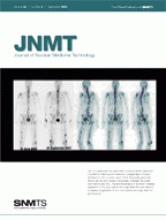
Mark Wallenmeyer, MBA, CNMT, RT(N) President, SNMTS
A year ago, the Technologist Section adopted a strategic plan endorsing specific goals to be implemented over the next one, three, and five years. These strategic actions were designed to be a guide as we address a variety of issues, including education, advocacy, and positioning SNMTS as the leader in providing a safe, painless, and non-invasive alternative for diagnosing and treating patients.
Briefly, the strategic plan calls for the Technologist Section to continue its work with existing educational programs to facilitate training on principles and concepts through preceptorship tracks, scholarships and grants, and networking. To meet these goals, we will maintain advocacy efforts for reimbursement and research funding as we monitor legislation that affects the profession. We will reinforce relationships with colleagues in related fields, both here in the United States and around the world. Finally, we will work on developing marketing messages and enlivening a recruitment campaign targeted at those in emerging technologies, advanced imaging modalities, and molecular imaging and therapy.
The following are the four main goals that we continue to expand.
SNMTS will be the indispensable resource in promoting and educating in knowledge exchange, training, and networking for nuclear medicine and molecular imaging and therapy.
SNMTS will be a powerful advocate for nuclear medicine and molecular imaging and therapy and promote the highest standard of patient care.
SNMTS will be a leader in educational and credentialing/licensing efforts for imaging specialists in nuclear medicine and molecular imaging and therapy.
SNMTS will be recognized as the society that positions technologists within the fields of nuclear medicine and molecular imaging and therapy.
Strategically, we know where we are headed and what we hope to accomplish in a given time frame. Now it's time we look at some of the progress SNMTS has made toward meeting our goals thus far.
On the education front, the new title we created for the advanced practice—Nuclear Medicine Advanced Associate—became official in March with approval from the American College of Radiology and was celebrated at SNM's 55th Annual Meeting in New Orleans in June. We also approved the final curriculum and are eagerly anticipating the first class starting in the spring 2009 term. This position will enable highly capable and motivated professionals to achieve an advanced degree as they increase their clinical responsibilities.
Also at the Annual Meeting, SNMTS officers approved a new, more comprehensive entry-level curriculum—including CT and MRI and other molecular imaging modalities—to ensure that those embarking on an education in nuclear medicine technology have a firm foundation on which to build. The curriculum for this program supports the need to have a standardized four-year degree for entry into the field, ensuring that graduates of nuclear medicine technology programs have the necessary skills to competently perform their jobs.
SNMTS continues to advocate for consistency, accuracy, responsibility and excellence (CARE) in Medical Imaging and Radiation Therapy legislation. The CARE legislation would require personnel performing the technical components of medical imaging and radiation therapy to meet federal education and credentialing standards in order to participate in federal health programs. Technologists have worked diligently to ensure passage by contacting their congressional representatives and urging their support. The message—that passage of the bill would result in enhanced patient safety and higher quality of medical imaging and radiation therapy services—is finally getting through to members of both the House and the Senate, and we have more support than ever before. We need to be persistent as we continue this effort and remain focused on passage of the bill. Members of the SNMTS Advocacy Committee champion this and other issues, including the USP 797 regulation that governs a wide range of pharmacy policies and procedures and CT state licensure issues.
Beyond our borders, SNMTS is reaching out to international colleagues. We recently extended SNMTS member rates to technologist members of the European Association of Nuclear Medicine (EANM) interested in attending our meetings. In addition to EANM, we are working to create good relations with the Canadian Association of Medical Radiation Technologists and the South African Society of Nuclear Medicine. Members of these associations are challenged by some of the same issues facing technologists in the United States, and we believe that in concert we will find the best solutions.
In closing, I would like to thank David Gilmore, SNMTS immediate past president, for his dedication and direction over the past year. His knowledge and leadership were invaluable to me as well as to the members of our various committees. I look forward to working with Cybil Nielsen, SNMTS president-elect, and am confident that she will bring great talent and enthusiasm to SNMTS's leadership. I am also eager to work with you—SNMTS members. Together we will bring about a positive effect for our patients and shape the future of nuclear medicine.







